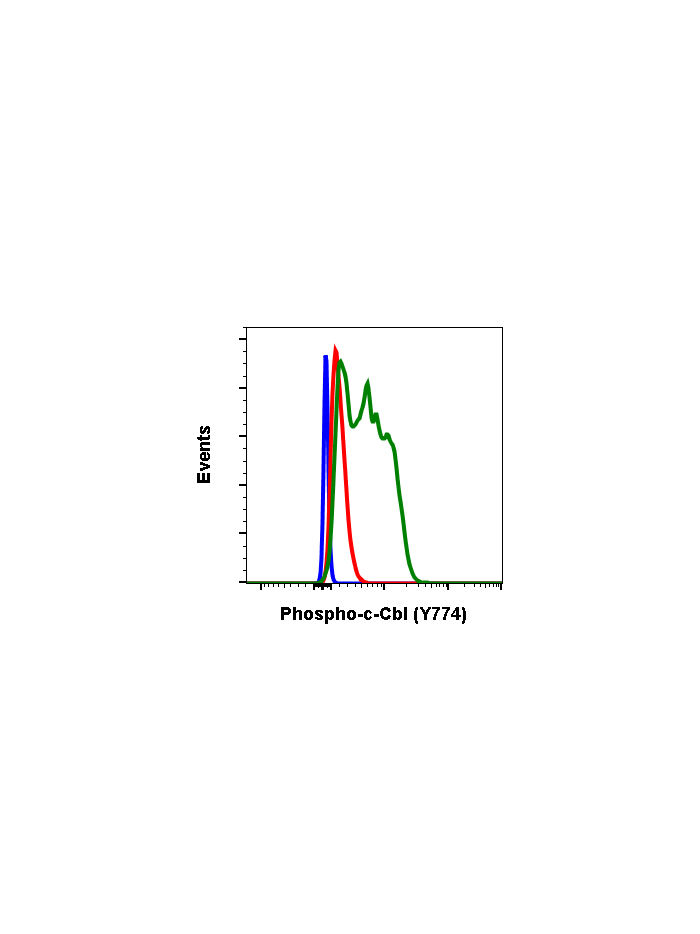Phospho-c-Cbl (Tyr774) (R4C5) rabbit mAb
From
$210.00
In stock
Only %1 left
SKU
2361
The c-Cbl (Casitas B-lineage Lymphoma) proto-oncogene is a ubiquitously expressed cytoplasmic adaptor protein that contains multiple functional domains, including an amino-terminal tyrosine kinase-binding (TKB) domain, a RING finger motif, and a proline-rich region. The TKB recognizes phosphorylated tyrosines on activated receptor tyrosine kinases (RTKs) and on other nonreceptor tyrosine kinases, while the RING finger motif recruits ubiquitin-conjugating enzymes. These two domains are primarily responsible for the ubiquitin ligase activity of c-Cbl and downregulation of RTKs (1). The proline-rich region contains 14-3-3 protein-binding and SH3 domain-binding motifs. c-Cbl is phosphorylated at Y700, Y731, and Y774 by Syk- and Src-family kinases after the stimulation of some integrins and a wide variety of receptors for immunoglobulins, antigens, hormones, growth factors, and cytokines. Phosphorylated Y774 interacts with the SH2 domain of Crk (1,2). The c-Cbl adapter protein is expressed in the cytoplasm in all tissues, with especially high levels of expression in hematopoietic cells (3,4). Through its many functional sites, c-Cbl plays key roles in the positive and negative regulation of vital cell functions, including T Cell Receptor-mediated cellular immune responses. In human cancer tissues, c-Cbl is frequently tyrosine-phosphorylated in a tumor-specific manner (5).
| Applications | Flow Cytometry, WB |
|---|---|
| Clone | CblY774-R4C5 |
| Format | Unconjugated |
| Validated Reactivity | Human, Mouse |
| Cross Reactivity | Predicted to work with mouse, rat and other homologues. |
| Detection | Anti-Rabbit IgG |
| Clonality | Monoclonal |
| Immunogen | A synthetic phospho-peptide corresponding to residues surrounding Tyr774 of human phospho c-Cbl |
| Formulation | 1X PBS, 0.02% NaN3, 50% Glycerol, 0.1% BSA |
| Isotype | Rabbit IgGk |
| Preparation | Protein A+G |
| Recommended Usage | 1µg/mL – 0.001µg/mL. It is recommended that the reagent be titrated for optimal performance for each application. See product image legends for additional information. |
| Storage | -20ºC |
| Pseudonyms | E3 ubiquitin-protein ligase CBL, Casitas B-lineage lymphoma proto-oncogene, Proto-oncogene c-Cbl, RING finger protein 55, RING-type E3 ubiquitin transferase, Signal transduction protein CBL, CBL2, RNF55 |
| Uniprot ID | P22681 |
| References | 1. Christine, B.F. et al. (2001) Nat. Rev. Mol. Cell Biol. 2: 294-307. 2. Feshchenko, E.A. et al. (1998) J. Biol. Chem. 273: 8323-8331. 3. Blake, T.J. et al. (1991) Oncogene. 6: 653-657. 4. Thien, C.B. and Langdon, W.Y. (1998) Immunol. Cell Biol. 76: 473-482. 5. Kamei, T. et al. (2000) Int. J. Oncol. 17: 335-339. |
Write Your Own Review



